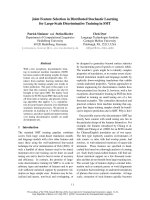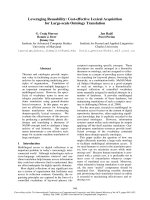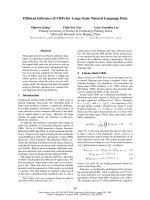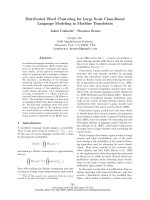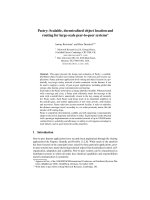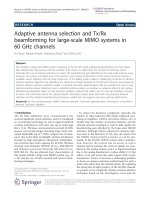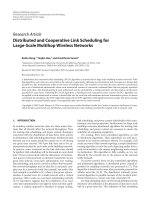Developing sub proteomic methods for large scale profiling
Bạn đang xem bản rút gọn của tài liệu. Xem và tải ngay bản đầy đủ của tài liệu tại đây (2.34 MB, 115 trang )
DEVELOPING SUB-PROTEOMIC METHODS FOR LARGE
SCALE PROFILING
TAN LAI PENG
(B.Appl.Sci. (Hons), NUS)
A THESIS SUBMITTED FOR THE DEGREE OF
MASTER OF SCIENCE
DEPARTMENT OF BIOLOGICAL SCIENCES
NATIONAL UNIVERSITY OF SINGAPORE
2003
ACKNOWLEDGMENTS
I wish to thank my supervisor, Dr Yao Shao Qin for giving me the opportunity
to do research in his laboratory, for his unwavering patience and
encouragement during these years, and all the advice and helps during the
writing of the thesis.
To my lab mates for making the lab a warm, friendly and interesting place to
work in.
To my net group members and friends, especially Cheryl for her prayers,
Raymond for his company and Jonathan for going through this Accelerated
Master Program with me.
To my family, especially my adorable siblings (David, Esther, John) for their
support and encouragement.
To God.
i
TABLE OF CONTENTS
Acknowledgments.................................................................................................i
Table of Contents ................................................................................................ ii
Summary..............................................................................................................vi
Publications...…………….…………………………………………………viii
List of Figures………………………………………………………………..ix
List of Abbreviations…………………………………………………………xi
Chapter 1: Introduction ........................................................................................3
1.1 Post-genomic era and its challenges........................................................3
1.2 Addressing the proteomic challenges......................................................5
1.2.1 Differential in-gel electrophoresis (DIGE) ........................................................ 5
1.2.2 Sub-proteomic expression profiling of proteins using activitybased probes (ABPs) ................................................................................................... 8
1.2.2.1 Reactive unit.............................................................................................. 8
1.2.2.2 Linker/recognition unit............................................................................ 10
1.2.2.3 Tag unit.................................................................................................... 11
1.2.2.4 Application of ABP in gel-based proteomics......................................... 12
1.3.1 Apoptosis .......................................................................................................... 15
1.3.1.1 Caspases................................................................................................... 16
1.3.1.2 Serine proteases in apoptosis .................................................................. 17
1.3 Aim of the project ..................................................................................19
1.3.2 Differential expression profiling of serine hydrolases in normal
and apoptotic cells ..................................................................................................... 20
ii
1.3.3 In vivo labeling of caspases in apoptotic HeLa cells ....................................... 21
Chapter 2: Materials and Methods.....................................................................24
2.1 Materials.................................................................................................24
2.2 GatewayTM Technology.........................................................................24
2.2.1 PCR amplification of a known serine hydrolase gene..................................... 24
2.2.2 BP reaction........................................................................................................ 25
2.2.3 LR reaction ....................................................................................................... 26
2.2.4 Transformation and induction of protein expression in BL21 (AI) ................ 26
2.4.4 Sequencing confirmation of clones.................................................................. 27
2.3 Preparation of bacterial and yeast cell lysate ........................................28
2.4 Estimation of protein concentration ......................................................28
2.5 In vitro labeling......................................................................................28
2.6 Affinity purification ...............................................................................28
2.7 Sodium dodecyl sulphate polyacrylamide gel electrophoresis (SDSPAGE) ..........................................................................................................29
2.8 Two-dimensional DIGE (2D DIGE) and imaging...............................29
2.9 Sypro ruby protein stain.........................................................................30
2.10 Western blot .........................................................................................30
2.11 Elution of whole protein from SDS-PAGE gel ..................................31
2.12 In-gel digestion of proteins..................................................................31
2.13 Matrix-assisted laser desorption ionization-time of flight (MALDITOF) mass spectrometry (MS)....................................................................32
iii
2.14 Preparation for apoptotic cells.............................................................32
2.14.1 Strains and culture condition.......................................................................... 32
2.14.2 Apoptosis induction of HeLa cells by Ultraviolet (UV)
irradiation ................................................................................................................... 32
2.14.3 In vivo labeling ............................................................................................... 33
2.14.4 Evaluation of apoptosis .................................................................................. 33
2.14.5 Preparation of HeLa cell extract .................................................................... 33
Chapter 3: Results ..............................................................................................35
3.1 Labeling and identifying of a commercially available serine hydrolase
......................................................................................................................35
3.2 Optimization of sample preparation steps.............................................37
3.3 Identification of serine hydrolases in yeast proteome...........................41
3.4 Differential profiling of serine hydrolases ............................................44
3.4.1 Proof of concept.............................................................................................. 44
3.4.2 Differential profiling of serine hydrolases in normal and
apoptotic HeLa cells .................................................................................................. 48
Chapter 4: Discussion ........................................................................................59
4.1 Labeling and identification of a commercially available serine
hydrolase……………………………………………………………….59
4.2 Optimization of sample preparation step ..............................................60
4.3 Identification of serine hydrolases in a yeast proteome........................62
4.4 Differential profiling of serine hydrolases ............................................65
4.4.1 Proof of concept................................................................................................ 65
iv
4.4.2 Differential profiling of serine hydrolases in normal and
apoptotic cells ............................................................................................................ 68
4.5 In vivo labeling of caspases ...................................................................71
4.5.1 In vivo labeling of caspases .............................................................................. 71
4.5.2 In vivo labeling of caspase-associated substrates ............................................ 73
4.6 Activity-based profiling.........................................................................77
Chapter 5: Conclusion........................................................................................80
Chapter 6: References ........................................................................................81
Chapter 7: Appendix ........................................................................................113
v
SUMMARY
With the availability of complete genome sequence, emphasis has
shifted towards the understanding of protein function. Two-dimensional gel
electrophoresis (2D-GE) is a state-of-the-art technique currently used for
large-scale studies of proteomes from different organisms. Due to its limited
resolution of detection (detecting 1000-5000 proteins), this technique alone,
however, is not sufficient to study complex proteomes, such as that of human
(>40,000 proteins). Thus, there is an urgent need to develop a so-called subproteomic approach which is capable of analyzing, with higher-resolution,
subsets of proteins in a proteome.
We have developed a functional proteomic methodology that makes
use of a combination of an emerging technology, DIGE and fluorescent
probes. The probes are made up of fluorophosphonates (FP) which are
mechanism-based suicide inhibitors of serine hydrolases. In DIGE, two pools
of proteins are labeled with 1-(5-carboxypentyl)-1-propylindocarbocyanine
halide (Cy3) FP probe and 1-(5- carboxypentyl)-1-methylindodi-carbocyanine
halide (Cy5) FP probe, respectively. The labeled proteins are mixed and
separated in the same 2D gel, allowing quantification of differential serine
hydrolases expression. Using Gateway Technology by Invitrogen, a known
serine hydolase was introduced into the bacterial expression host. Differences
vi
in expression of the serine hydrolase between induced and uninduced
condition were quantified by 2D DIGE. This methodology was further
extended into quantifying differences in the expression of serine hydrolases
between normal and apoptotic cells.
In another part of the project, we report efficient labeling of caspases
expressed inside apoptotic HeLa cells using fluorescently-labeled or
biotinylated, fluoromethylketone (fmk)-containing probe. Preliminary results
with these probes indicated that they were highly cell-permeable, and caspase8 has been identified by biotinylated fmk-containing probe.
In conclusion, 2D DIGE, in combination with fluorescent probes and
MS, will become a powerful tool for molecular characterization of cancer
progression and identification of cancer-specific protein markers.
vii
PUBLICATIONS
1.
Huang, X., Tan, E.L.P., Chen, G.Y.J., Yao, S.Q. “Enzymetargeting small molecule probes for proteomics applications”,
Appl. Genomics Proteomics, 2003, in press.
2.
Tan, E.L.P., Panicker, R.C., Tan, L.P., Chattopadhaya, S., Yao,
S.Q. “Developing chemical biology tools for the study of
functional proteomics”, Proceedings of the 1st International
Symposium on Biomolecular Chemistry, Japan.
3.
Tan, E.L.P., Yao, S.Q. “Activity-based, differential expression
profiling of serine hydrolases in different proteomes”, manuscript
in preparation
4.
Tan, E.L.P, Panicker, R.C., Yao, S.Q. “In vivo activity-based
profiling of caspases and their associated proteins”, manuscript in
preparation.
viii
LIST OF FIGURES
Number
Page
Figure 1 Strategy of 2D difference gel electrophoresis (DIGE) .........................7
Figure 2 General structure of an activity-based probe ........................................8
Figure 3 Strategy of gel-based activity profiling using ABP............................13
Figure 4 Caspase activation cascade..................................................................17
Figure 5 Structure of FP-Cy3.............................................................................20
Figure 6 Structure of FP-Cy5.............................................................................21
Figure 7 Structure of FP-Biotin .........................................................................21
Figure 8 Structure of caspase-biotin ..................................................................22
Figure 9 Structure of caspase-fluorescein .........................................................23
Figure 10 SDS-PAGE of FP-Cy5-labeled chymotrypsin .................................35
Figure 11 MALDI-TOF-MS spectrum of undigested chemotrypsin ...............36
Figure 12 MALDI-TOF-MS spectrum of digested chymotrypsin ...................36
Figure 13 Chymotrypsin matched peptide alignment sequences .....................37
Figure 14 Optimization of lysis and labeling condition....................................38
Figure 15 2D fluorescent gel of FP-Cy5 labeled yeast proteins. ......................38
Figure 16 2D gel showing FP-Cy5 labeled yeast fluorescent spots. ................40
Figure 17. 2D gel showing FP-biotin labeled proteins from yeast lysate.........42
Figure 18 Protein sequence alignment of sec17 and sec11 using ClustalW ...43
Figure 19 : The GatewayTM system ...................................................................45
Figure 20 PCR analysis to verify the presence of the gene, YSP3, in bacteria
expression host BL21 (AI).................................................................................45
Figure 21 YSP3 Basepair alignment of the sequencing results ........................46
Figure 22 Over-expression of YSP3 by arabinose induction in bacteria
expression host BL21 (AI).................................................................................47
Figure 23 DIGE of induced and non-induced transformed bacterial lysates. ..47
ix
Figure 24 Normal (a) and apoptotic (b) HeLa cells ..........................................50
Figure 25 DIGE of normal and apoptotic cell lysates.......................................50
Figure 26 HeLa cells labeled with caspase-fluorescein ....................................53
Figure 27 Normal and apoptotic HeLa cells labeled with caspase-fluorescein..
.............................................................................................................................53
Figure 28 Fluorescent gel images of caspase-fluorescein labeled normal and
apoptotic HeLa cells...........................................................................................54
Figure 29 Caspase-fluorescein labeling of apoptotic HeLa cells at different
time point after UVB-irradiation .......................................................................54
Figure 30 Comparison of fluorescence (a) and biotin-avidin (b) detection
modes for analyzing caspases. ...........................................................................55
Figure 31 MALDI-TOF-MS spectrum of caspase-8.........................................56
Figure 32 Caspase-8 matched peptide alignment sequences ............................56
Figure 33 Comparing protein patterns between 2 Coomassie-stained images:
(a) caspase-biotin-labeled HeLa cell lysate (b) unlabeled HeLa cell lysate.....57
Figure 34 Schematic representation of the regulation based on araBAD.........67
Figure 35 A possible scenario in the less stringent condition...........................76
x
LIST OF ABBREVIATION
2D-GE
Two-dimensional gel electrophoresis
ABP
Activity-based probe
BTEE
N-benzoyl-L-tyrosine ethyl ester
Cy2
Cyanine-2
Cy3
Cyanine-3
Cy5
Cyanine-5
DFP
diisopropylfluoro-phosphate
DIGE
Differential in-gel electrophoresis
fmk
fluoromethylketone
FP
fluorophosphonate
IEF
isoelectric focusing
MALDI-TOF
matrix-assisted laser desorption ionization-time of flight
MS
mass spectrometry
PBS
phosphate-buffered saline
PCR
Polymerase Chain Reaction
SDS-PAGE
Sodium dodecyl sulphate polyacrylamide gel electrophoresis
TAME
N-tosyl-L-argininemethyl ester
TLCK
N-tosyl-L-lysine chloromethyl ketone
TPCK
N-tosyl-L-phenylalanine chloromethyl ketone
xi
UV(B)
Ultraviolet- (B)
PA28γ
proteasome activator 28 subunit 3
ER
endoplasmic reticulum
xii
Chapter 1
INTRODUCTION
1.1 Post-genomic era and its challenges
Over the past two decades, there is an increasing number of prokaryotic and
eukaryotic organisms being sequenced. From a 49-kbp (base pair) bacteriophage lambda
genome (Sanger F. et al., 1982) to a 2.91-billion bp human genome (Venter J.C. et al.,
2001), these, nevertheless, provide an exciting blueprint to understand cell biology.
However, these huge sets of DNA sequences are insufficient, as it is known that proteins are
ultimately responsible for most processes that take place within the cells. Therefore,
PROTEOMICS (the analysis of the entire PROTEin complement expressed by a genOME),
as defined by Marc Wilkins and Keith Williams (1996), grow increasingly important in the
post-genomics era (Fields S. et al., 2001).
It has been estimated that the human proteome could contain from as few as
100,000 different proteins, to as many as a few million. By studying the dynamic
description of gene regulation, proteomics techniques offers a powerful tool to unravel
gene functions, holding promises to significantly impact our understanding of the
molecular composition and function of cells. The changes in protein profiles, for example
under the influence of different signals, bacterial/viral infection, or environmental factors,
can be monitored and quantitated. These will provide a powerful tool to identify proteins
that can be potential targets for diagnostic or therapeutics.
3
Presently, the most sophisticated strategy to globally profile proteome is 2DE-MS,
which combines 2D-GE, mass spectrometry (MS) and sequence database analysis. (Jessani
N. et al., 2002) Proteins are resolved as spots and cleaved proteolytically. The resulting
peptides are subjected to mass spectrometric analyses, followed by respective ‘mass-map’
(or ‘mass-fingerprint’) and ‘sequence-tag’ searches in protein sequence databases for
identification.
Despite its wide application, this strategy is not without limitations. Firstly, when
comparing protein differences between two samples, comparison of images from at least 2
different gels must be made. But because of variations between gels, due to subtle changes
in experimental conditions, no two gel images are directly superimposable. Very often,
each sample must be run on several replicate gels to generate electronic ‘average’ gels
which can then be compared. As a result, high through-put analysis of many samples
becomes tedious and impractical and subtle changes in the number of proteins and their
expression levels between samples might be easily overlook. Secondly, current detection
methods of 2DE rely on staining methods like Coomassie blue and silver staining. The
latter, though being more sensitive and widely used, but it is still unsuitable for accurate
quantitative analysis due to its limited dynamic range. Therefore, 2D-GE can only be used
to analyze a small fraction of highly abundant proteins (<5000) in a proteome (Gygi S.P.
et al., 2000). Membrane-bound and low abundance proteins, which are frequently the
protein interest of many researchers, have proven difficult to be analyze by 2D-GE,
thereby rendering the technique insufficient for large-scale protein profiling in human.
4
1.2 Addressing the proteomic challenges
In this section, two strategies that have been developed to address the two 2D-GE
limitations mentioned above will be presented.
1.2.1 Differential in-gel electrophoresis (DIGE)
DIGE has been developed by Unlu M. et al (1997) to address the issue on
difficulties of superimposing two 2D gels. This technique relies on pre-electrophoretic
labeling of each of the comparing samples with one of the three spectrally distinct
fluorescent dyes, Cyanine-2 (Cy2), Cyanine-3 (Cy3), and Cyanine-5 (Cy5). The dyes have
an NHS-ester reactive group and are designed to covalently attach to epsilon amino group
of lysine of proteins via an amide linkage.
The labeled samples are then quenched, mixed and run on a single gel. Because the
dyes are structurally similar, same proteins from different samples will co-migrate as same
spots on the same gel. Quantitation of differential protein expression is made easy by
viewing the gel at different wavelengths and by comparing the intensity difference of the
two different labels on the same spot (Figure 1). This positional reproducibility means
image overlay rapidly shows any difference in protein levels between samples, and also
accelerates image analysis, enabling higher sample throughput.
In addition, there are other advantages for DIGE over conventional 2D-GE. First,
optimized DIGE technology is capable of detecting about half as many proteins as
conventional silver staining, or four times as many proteins as colloidial Coomassie Blue
5
staining (Tonge R. et al., 2001). It has been reported that DIGE is able to detect down to at
least 500 pg of a protein (Orange P. et al., 2000). Second, DIGE has a linear response to
variation in protein concentration over four orders of magnitude (104) (Tonge R. et al.,
2001). This enables DIGE to provide more accurate quantitative data in less time than is
achieved with traditional silver staining, which is only linear over 60-100 fold differences in
protein concentration (Patton W. et al., 2000; Orange P. et al., 2000)
To date, DIGE has been successfully used to profile changes in protein expression in
several toxicity studies (Ruepp S.U. et al, 2002, Smith D.R. et al, 2003) and in comparison
between normal and cancer/diseased cells (Gharbi S. et al, 2002, Zhou G. et al 2002, Lee
J.R. et al, 2003, Yamanaka H. et al, 2003) In one of the works by Zhou G. et al (2002),
DIGE was applied to quantify the differences between laser capture microdissectionprocured esophageal carcinoma cells and normal epithelial cells. Of the detected proteins,
58 spots were up-regulated by >3-fold and 107 were down-regulated by >3-fold in cancer
cells. They have shown that 2D DIGE when combine with mass spectrometry can be a
powerful tool for molecular characterization of cancer progression and identification of
cancer-specific protein markers.
In another work by Hu et al (2003), they reported the first case to explore the highthroughput feature of DIGE, which detect changes in the yeast proteome under 15
different metal stresses. About 50 yeast proteins which were either up-regulated or downregulated during the metal stresses were identified.
6
Protein extract 1
Protein extract 2
Label with fluorochome 1
Label with fluorochome 2
Mix labeled extracts
Separate by 2D electrophoresis
Image gel
Excitation wavelength 1
Excitation wavelength 2
Image analysis and data quantification
Image overlay
Image subtraction
Figure 1 Strategy of 2D DIGE
7
1.2.2 Sub-proteomic expression profiling of proteins using activity-based probes (ABPs)
As mentioned before, more than 100 000 proteins are expected from the genome
and millions of protein-protein interactions are possible in protein complexes and
networks. Hence, fractionating the proteome into manageable and physiologically relevant
subsets becomes relevant and critical. This can be made possible with the use of activitybased probe (ABP), which has been developed to globally profile a subset of a proteome
(sub-proteome). Generally, ABP are made up of three units: reactive unit, linker/recognition
unit and tag unit (Figure 2). The components and functions of each unit will be elaborated in
following sections. Each type of probe labels or isolates only a specific class of enzymes.
For example a fluorophosphonate (FP) probe synthesized by Cravatt’s group targets the
serine hydrolase family of enzyme (Liu Y. et al. 1999), while another probe synthesized by
Bogyo’s group targets the papain family of cysteine proteases (Greenbaum D. et al., 2002).
Linker/Recognition unit
Tag
Reactive unit
Figure 2 General structure of an activity-based probe
1.2.2.1 Reactive unit
An ideal ABP should be able to carry out specific labeling reactions on ONLY its
targeting proteins present in a complex proteome, and after which, the protein-probe
complexes be able to withstand harsh washing conditions during purification steps, as well
8
as denaturing conditions during gel-based separation of probe-labeled proteins from
unlabeled proteins. This can only occur when an irreversible complex is formed between
the probe and targeting enzyme, typically as a result of covalent reactions. In cases where
non-covalent complex is formed, the enzyme loses its 3-dimensional structure under the
denaturing conditions, readily detach itself from the probe, leading to subsequent
dissociation of the complex. Consequently, the main function of the reactive units within
the ABP is to ensure irreversible, covalent bonds are formed between the probe and
enzymes it targets. The reactive units in ABPs are made up of mechanism-based substrates
or suicide inhibitors, which label enzymes during the catalytic process.
The chemical groups on different reactive units may be fine tuned to target different
classes of enzymes based on their enzymatic activity under a complex background of other
enzymes in a proteome. Most ABPs use electrophilic chemical groups as their reactive
units, which, upon binding to the enzymes, are able to selectively, as well as covalently,
modify the active sites of the enzymes (Jeffery D.A. et al. 2002). This strategy is quite
general, as most, if not all, enzymes invariably contain nucleophilic groups within their
active sites, which provide good “electrophilic traps” for the reactive unit in the probe.
The ABPs reported thus far can be divided into two types, based on mechanisms by
which their reactive units covalently label the enzymes. The first type is true mechanismbased probes which is designed by using actual enzyme mechanism as blueprint and is able
to covalently modify the enzyme catalytic center. Examples of such ABP include:
epoxysuccinyl derivatives, acyloxymethyl ketones, and peptidyl vinyl sulfone which target
cysteine protease (Thornberry N.A. et al. 1994, Greenbaum D. et al.2000, Wang G. et al.
2003), fluorophosphonate (FP) group which target serine hydrolases (Liu Y. et al. 1999) and
9
sulfonate ester which target several different classes of enzymes (Thiolase, aldehyde
dehydrogenase, NAD/NADP-dependent oxidoreductase, epoxide hydrolase, glutathione Stransferase) (Adam G.C. et al. 2001, 2002a). The second type of reactive unit is based on
suicide inhibitors and requires enzyme to cleave the substrate to uncover highly active
nucleophilic group which can eventually react with nearby protein residues. Examples of
suicide inhibitor probes are p-hydroxymandelic acid derivatives and 2-difluoromethylphenyl
phosphate targeted to phosphatases (Lo L.C. et al.1996, Betley J.R. et al. 2002, Lo L. et
al.2002, Zhu Q. et al.2003).
1.2.2.2 Linker/recognition unit
In a typical ABP, the reactive and the tag units have different biological functions
upon binding to the target enzyme. The reactive unit typically contains certain chemical
functionality that is recognized, and subsequently becomes reactive toward the active site of
the enzyme. The tag unit on the other hand, is typically made up of either a fluorescent
molecule (e.g. FITC, Cy3 & Cy5 etc) or an affinity tag (e.g. biotin), which in many cases is
detrimental to the binding between the probe and the enzyme. Consequently, it is often
necessary to have a linker unit, within the ABP, which serves not only to bridge the two
units together, but also to minimize the overall binding interference of the tag unit toward
the enzyme. Additionally, the linker unit in many cases also serves as part of the enzymerecognizing unit in facilitating the reactive unit-enzyme binding, as well as defining
differential specificity of a probe toward different enzymes within the same class.
10
There are generally two types of linker: sequence-specific and nonspecific linkers.
The first type is rarely used in broad-based ABP, because they are typically made up of
defined peptide sequence and are highly specific to their targeting enzymes. The nonspecific
linkers are more commonly used, as they are well-suited for potential large-scale protein
profiling experiments, which aim to simultaneously target many different enzymes within
the same class. These linkers are typically made up of long aliphatic chains of either
hydrophobic (e.g. alkyl chains) or hydrophilic molecules (e.g. polyethylene glycols,
polyglycines), which serve to modulate the probes’ activities (e.g. reactivity, solubility etc)
(Kidd D. et al. 2001).
1.2.2.3 Tag unit
The tag unit is incorporated into an activity-based small molecule probe to facilitate
sensitive detection, quantitation, isolation and the subsequent identification of enzymes
upon their labeling by the probe. Most commonly used tags are: biotin and its derivatives,
fluorescent dyes, isotopes and others, just to name a few.
Biotin is an affinity tag, its interaction with streptavidin is one of the strongest noncovalent interactions known and can stand a relatively harsh washing condition. (Green
N.M. et al. 1973, Reznik G.O. et al. 2001) The biotin tagged-probe labeled protein can be
isolated, concentrated and purified by streptavadin-agarose bead from the crude cell lysate
and subsequently identified by MS. This strategy is valuable to detect low abundance
enzyme. The labeled protein can also be separated by gel based method and visualized by
commercially available western blot detection kit (Bio-rad website). However, very often
11
endogenously biotinylated proteins and unspecific binding will introduce false positive
result.
When compared to biotin, fluorescent tag offer more advantages. Firstly, fluorescent
tag can be visualized directly and efficiently by a fluorescence-based scanner. Unlike the
biotin-streptavidin system mentioned above, it does not require several hours of antibody
incubation and washing steps and hence are more compatible to high-throughput proteomic
experiments. Secondly, the versatile choices of fluorescence tags, such as Cy3, rhodamine,
fluorescein, and so on, makes it possible for multiplexing experiment in which a mixture of
probes with different fluorescence tags be used to profile different targeted enzyme in the
same proteome sample or same targeted enzyme from different proteome samples. Thirdly,
fluorescent tag also offers higher sensitivity and wider dynamic range than biotin tag. For
example, 0.1 fmol of enzyme can be detected by fluorescence tag labeled probe, which is
100-fold better than biotin tag labeled probe (Patricelli M.P. et al. 2001).
1.2.2.4 Application of ABP in gel-based proteomics
ABP can provide valuable information (eg differential enzyme activities) only when
it is used with other proteomics techniques. Currently, ABP have been successfully
combined with two existing proteomics platforms, namely gel-based proteomics (Cravatt
B.F. et al., 2000; Jessani N. et al., 2002; Weihofen A. et al., 2002) and microarray-based
technologies (Chen et al., 2003). Due to the nature of this project, the latter will not be
discussed and only the former will be elaborated.
ABP, when combined with 2DE-MS, simultaneously detects changes in the activity
of many proteins of the same class in the cells, tissues and fluid samples. (Cravatt B.F. et
12
al., 2000). Typically, proteins, which were extracted from cells or tissues, were incubated
with ABP, and followed by separation by gel-based techniques like sodium dodecyl
sulphate polyacrylamide gel electrophoresis (SDS-PAGE), and the tag signal of each bands
were detected by a suitable techniques (e.g. fluorescence imaging or western blots). The
activities of the probe-labeled enzymes may be profiled and MS was carried out to identify
the labeled proteins (For overall scheme refer to Figure 3).
Proteome (extracted cell lysate)
Incubation with fluorescent ABP
SDS-PAGE
Fluorescent image
MS
Figure 3 Strategy of gel-based activity profiling using ABP
13
An example of a work carried out by Jessani N. et al. (2002) is the profiling of
serine hydrolases activity of a panel of breast and melanoma cell lines. In this paper, two FP
probes were used, one was rhodamine- coupled FP probe for easy profiling of serine
hydrolases activity, and another was biotin coupled FP probe for rapid isolation and
identification of labeled proteins. By quantitatively comparing the profiling data of different
cell lines, a serine hydrolase (KIAA1363) was found to be a molecular marker for cancer
cell invasiveness. This work aptly demonstrated the potential of ABP in enzyme activity
profiling and their subsequent contribution to the diagnosis and possible treatment for
cancers.
Another application of enzyme-targeting probes is in the identification of new
functions in unknown proteins from a proteome. Because the probe is able to specifically
label a class, or in some instances a few classes, of enzymes, it could be used to characterize
previously uncharacterized enzymes in a proteome based on their activity. An example of
this type of work is in the identification of a novel signal peptidase by TBL4K probe
(Weihofen A. et al., 2002). The authors used the probe to label the detergent-solubilized,
ER-membrane subproteome, followed by separation on a SDS-PAGE. They identified a
42-kD protein, which was labeled by TBL4K probe in the presence of detergents. Upon
further analysis by MS, the protein was confirmed to be a previously uncharacterized
protein. Consequently, they were able to further classify the protein as a signal peptidase,
belonging to a class of rare proteins called intramembrane proteases.
14
